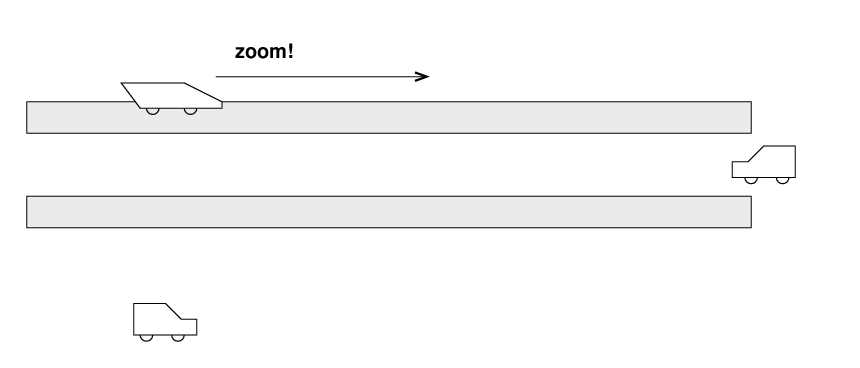Lieutenant Jones reports to Inspector Smith. "We have two suspects, a Romulan ship and a Klingon freighter. Both claim to be travelling at constant speed and direction through the relativistic shipping lanes, though the Klingons are moving much faster. We asked the captain of each ship what she knew about the mystery object. The Romulan captain reported that it had a total energy of 7.63 x 1039 Joules, and the Klingon captain said the total energy was 1.52 x 1040 Joules."
Smith grunts. "That's consistent with what we know about their speeds. Did they say anything about the momentum of the object?"
Jones answers, "Yes, we questioned their science officers. The Romulans measure 1.27 x 1031 kg*m/s, and the Klingons report 3.25 x 1031 kg*m/s."
Smith thinks for a moment, then slams his fist on the table. "That's it! We've got them!"
- Who is lying?
- How do you know?

On a long, straight, East-West stretch of the highway near Rochester, the police have two options: they can place a monitoring station hidden in a clump of trees, about 100 meters to the south of the road, and measure the frequency of cars going past that spot; or, they can place a squad car in the median strip, at the far eastern end of the straight section, and measure the frequency of cars coming toward the officer there.
- Suppose a car drives East at v = 0.7c. What is the frequency measured by each squad car?
- Suppose that a car drives at only slightly-relativistic speeds, around 0.05 c. Can you prove mathematically that one location is always a better choice than the other?
- How much longer?

- How fast is the biker cruising to the East?
- What is the time interval between events "A" and "B" according to Bob?
- What is the time interval between events "A" and "B" according to the Biker?
- What is the time interval between events "B" and "C" according to Jane?
- What is the time interval between events "B" and "C" according to the Biker?
- When did the Biker flash his taillight, according to Bob?
- When did the Biker flash his taillight, according to the Biker?
Points "A" and "B" represent the alarm clocks of Bob and Jane both going off, and point "C" is when the Biker passes Jane. At "C", the Biker's clock reads 5 m.
The biker flashes his taillight at some time before he passes Jane. The flash of red light reaches Bob at point "D".
- Assume further that the difference in time passing for Corbell and Earth-people is due entirely to the time dilation factor. Based on the time differences, how fast was Corbell flying?
- Now, using that speed, compute how long a simple round trip to the galactic center SHOULD have taken (in other words, compute the Earth time based on the distance travelled and speed).